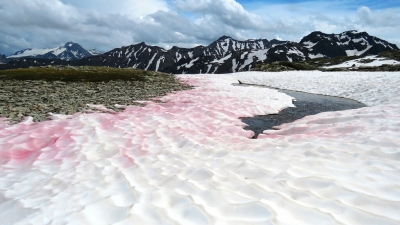
In high latitude regions around the world including the Arctic, the snow is often coloured pink or red. Called watermelon snow or blood snow, the phenomenon has been observed and remarked on for centuries. Explorers to the North Pole in the 19th Century thought the red colour was due to iron deposited by meteorites.
Today, scientists know that the culprit is an alga, a microorganism called Chlamydomonas nivalis. It is an extremophile, that is, it can survive extremely cold temperatures. The alga which is normally green, turns red when it begins absorbing ultraviolet rays from the sun. It colonizes whole areas, pushing its way up through the snow in streaks and patches, making for a striking sight. Hikers coming across watermelon snow may be forgiven for mistaking it to be the scene of a particularly gory accident!
Watermelon snow looks attractive, but it hides a disturbing fact. A recent study by a team of geo-biologists from Britain and Germany has shown that it has increased the rate of Arctic melt, which is already at dangerous levels because of global warming. Dark surfaces absorb more light and therefore more heat energy. Snow being white, normally reflects most of the light striking it. The red alga decreased the quality of light reflected by the snow. This caused the snow to melt at a much faster rate.
As the snow thaws, it enables the alga to bloom more quickly and spread, causing even more snow to melt.
Picture Credit : Google

